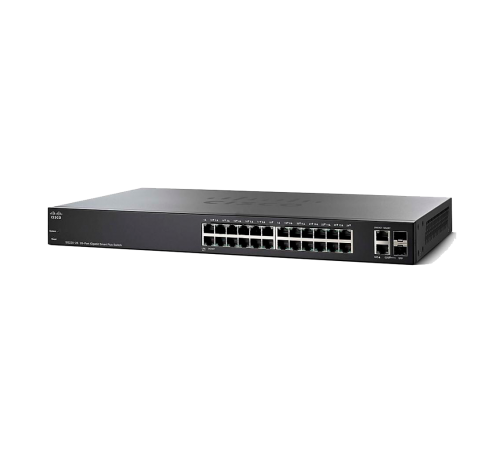
Комутатор Cisco SB SG220-28MP (SG220-28MP-K9-EU) - у
Cisco® 220 Series, що входить у портфель Cisco для малого та середнього бізнесу, є серією доступних інтелектуальних комутаторів, що забезпечують безпеку, продуктивність та простоту використання, які допомагають побудувати надійну бізнес-мережу в рамках обмеженого бюджету. Комутатори забезпечують потужну комбінацію функцій за нижчою ціною, ніж керовані комутатори.
Серія Cisco 220 включає широкий спектр інтелектуальних комутаторів, які забезпечують доступ до Fast Ethernet і Gigabit Ethernet з опціями Power over Ethernet (PoE) Plus. Завдяки інтуїтивно зрозумілому веб-інтерфейсу, енергозберігаючим технологіям і багатим функціям, що настроюються, ці комутатори можуть не тільки підвищити продуктивність вашого бізнесу сьогодні, але й задовольнити зростаючі потреби в мережі в майбутньому.
Model name | Order product ID | Description |
Fast Ethernet | ||
| SF220-24 | SF220-24-K9-xx | 24 10/100 ports |
| SF220-24P | SF220-24P-K9-xx | |
| SF220-48 | SF220-48-K9-xx | 48 10/100 ports |
| SF220-48P | SF220-48P-K9-xx | 48 10/100 PoE+ ports with 375 W power budget |
Gigabit Ethernet | ||
| SG220-26 | SG220-26-K9-xx | 24 10/100/1000 |
| SG220-26P | SG220-26P-K9-xx | 24 10/100/1000 |
| SG220-28MP | SG220-28MP-K9-xx | 24 10/100/1000 4 Gigabit SFP port |
| SG220-50 | SG220-50-K9-xx | 48 10/100/1000 ports |
| SG220-50P | SG220-50P-K9-xx | 48 10/100/1000 PoE+ ports with 375 W Power budget |
Feature | Description | |||||
Performance | ||||||
Switching Capacity | Model name | Forwarding rate in millions of packets per second (mpps; 64-byte packets) | Switching capacity in Gigabits per second | |||
SF220-24 | 6.55 | 8.8 | ||||
SF220-24P | 6.55 | 8.8 | ||||
SF220-48 | 10.12 | 13.6 | ||||
SF220-48P | 10.12 | 13.6 | ||||
SG220-26 | 38.69 | 52 | ||||
SG220-26P | 38.69 | 52 | ||||
SG220-28MP | 41.67 | 56 | ||||
SG220-50 | 74.40 | 100 | ||||
SG220-50P | 74.40 | 100 | ||||
Layer 2 switching | ||||||
MAC table | Up to 8,192 MAC addresses | |||||
Spanning Tree Protocol (STP) | Fast convergence using 802.1w ( Rapid Spanning Tree [RSTP]) Multiple Spanning Tree instances using 802.1 s (MSTP) 16 instances are supported | |||||
Port grouping | Support for IEEE 802.3ad Link Aggregation Control Protocol (LACP) ● Up до 8 груп ● Up до 8 портів на групу з 16 candidate ports для кожного (динамічний) 802.3ad link aggregation Load balance based on source and destination MAC address, або source and destination MAC/IP | |||||
VLAN | Support for up to 256 VLANs simultaneously Port-based and 802.1Q tag-based VLANs Management VLAN Guest VLAN | |||||
Auto voice VLAN | Voice traffic is automatically assigned to a voice-specific VLAN and treated with appropriate levels of QoS | |||||
QinQ VLAN | VLANs transparently cross a service provider network while isolating traffic among customers | |||||
Generic VLAN Registration Protocol (GVRP ) and Generic Attribute Registration Protocol (GARP) | Protocols for automatically propagating and configuring VLANs in a bridged domain | |||||
Head-Of-Line ( HOL) blocking | HOL blocking prevention | |||||
Jumbo frame | Frame sizes up to 9,216 supported | |||||
Loopback detection | It operates independently of STP. | |||||
Automatic Media-Dependent Interface Crossover (MDIX) | Automatically adjusts transmit and receive pairs if an incorrect cable typ (crossover or straight-through) is installed. | |||||
Security | ||||||
ACLs | Drop or rate limit based on source and destination MAC, VLAN ID або IP address, protocol, port, Differentiated Services Code Point (DSCP)/IP precedence, TCP/UDP source and destination ports, 802.1p priority, Ethernet type, Internet Control Message Protocol (ICMP) packets, IGMP packets, TCP flag Support up to 511 | |||||
Port security | Creates the ability to lock source MAC address to ports; limits the number of learned MAC addresses | |||||
IEEE 802.1X (authenticator role) | Single-host, multiple- host, і multisession mode | |||||
RADIUS, TACACS+ | Supports RADIUS and TACACS authentication; switch functions as a client | |||||
MAC address filtering | Supported | |||||
Storm control | Broadcast, multicast, and unknown unicast | |||||
DoS protection | DOS attack prevention | |||||
This security mechanism protects the network from invalid configurations. port enabled for BPDU Guard is shut down if BPDU message is received on that port | ||||||
Spanning Tree Loop Guard | ||||||
Secure Shell (SSH) Protocol | SSH is a secure replacement for Telnet traffic. SCP такожвикористання SSH. SSH v1 і v2 є supported | |||||
Secure Sockets Layer (SSL) | SSL support: Encrypts all HTTPS traffic, дозволяючи високому доступу до браузера-базованого управління GUI в режимі switch | |||||
QoS | ||||||
Priority levels | 8 hardware queues per port | |||||
Scheduling | Strict priority and Weighted Round- Robin (WRR) queue assignment based on DSCP and class of service (802.1p/CoS) | |||||
Class of service | Port-based; 802.1p VLAN priority-based; IPv4/v6 IP precedence, Type of Service (ToS), and DSCP-based; Differentiated Services (DiffServ); classification and re-marking ACLs, trusted QoS | |||||
Rate limiting | Ingress policer; egress shaping and rate control; per VLAN, per port, and flow-based | |||||
Congestion avoidance | A TCP congestion avoidance algorithm is required to reduce and prevent global TCP loss synchronization | |||||
Multicast | ||||||
Internet Group Management Protocol (IGMP) ) Versions 1, 2, and 3 Snooping | IGMP limits bandwidth-intensive multicast traffic to only the requesters; supports 256 multicast groups | |||||
IGMP querier | IGMP querier is used to support a Layer 2 multicast domain of snooping switches in the absence of a multicast router | |||||
Standards | ||||||
Standards | IEEE 802.3 10BASE-T Ethernet , IEEE 802.3u 100BASE-TX Fast Ethernet, IEEE 802.3ab 802.1w RSTP, IEEE 802.1 802.3af, IEEE 802.3at , RFC 768, RFC 783, RFC 791, RFC 792, RFC 899, RFC 89, RFC 899, RFC 89 920, RFC 950, RFC 1042, RFC 1071, RFC 1123, RFC 1141, RFC 1155, RFC 1157, RFC 1350, RFC 1533, RFC 1541, RFC 1624, RFC 1700, RFC 1867, RFC 2030, RFC 2616, RFC 1573, RFC 1643, RFC 1757, RFC 1907, RFC 2011, RFC 2012, RFC 2013, RFC 2233, RFC 1493, RFC 1215, RFC 3416 | |||||
IPv6 | ||||||
IPv6 | IPv6 host mode IPv6 over Ethernet IPv6/IPv4 Dual Stack IPv6 neighbor and router discovery ( ND) IPv6 stateless address auto-configuration Path Maximum Transmission Unit (MTU) ) discovery Duplicate Address Detection (DAD) ICMP version 6 | |||||
IPv6 ACL | Drop or rate limit IPv6 in hardware | |||||
IPv6 QoS | Prioritize IPv6 packets in hardware | |||||
Multicast Listener Discovery (MLD v1 /2) Snooping | Deliver IPv6 multicast packets only to the required receivers | |||||
IPv6 applications | Web/SSL, Telnet server /SSH, DHCP Client, DHCP Autoconfig, CDP, LLDP | |||||
IPv6 RFCs supported | RFC 4443 (which obsoletes RFC2463 ) - ICMP version 6 RFC 4291 (which obsoletes RFC 3513) - IPv6 address architecture RFC 4291 - IPv6 addressing architecture RFC 2460 - IPv6 specification RFC 4861 (which obsoletes RFC 2461) - Neighbor discovery for IPv6 RFC 4862 (which obsoletes RFC 2462) - IPv6 stateless address auto-configuration RFC 1981 - Path MTU discovery RFC 4007 - IPv6 scoped address architecture RFC 3484 - Default address selection mechanism | |||||
Management | ||||||
Web user interface | Built-in switch configuration utility for easy browser-based device configuration (HTTP/HTTPS). Supports configuration, system dashboard, system maintenance, and monitoring | |||||
Text-editable config files | Config files can be edited with a text editor і downloaded до іншого switch, faciliting easier mass deployment | |||||
Command-line interface | Scriptable CLI; a full CLI is supported. User privilege рівнів 1 і 15 є підтриманими для CLI | |||||
Cloud services | Support for Cisco FindIT Network Manager | |||||
SNMP | SNMP versions 1, 2c, and 3 with support for traps, and SNMP version 3 User-based Security Model (USM) | |||||
Standard MIBs | MIB-II (RFC1213) IF-MIB (RFC2863) Bridge-MIB (RFC4188) Bridge-MIB-Extension ( RFC2674) RMON (RFC2819) Etherlike MIB (RFC3635) Radius Client MIB (RFC2618) Entity MIB (RFC2737) POWER-ETHERNET-MIB ( RFC3621) Syslog MIB (RFC3164) | Generic Traps MIB (RFC1215) SNMP-COMMUNITY-MIB SNMP-MIB LLDP-MIB LLDP-EXT-MED- MIB IEEE8023-LAG-MIB CISCO-PORT-SECURITY- MIB CISCO-ENVMON-MIB CISCO-CDP-MIB CISCO-CONFIG-COPY-MIB | ||||
Remote Monitoring (RMON) | Embedded RMON software agent supports 4 RMON groups (history, statistics, alarms, and events) для покращеного транспортного управління, monitoring, and analysis | |||||
IPv4 and IPv6 dual stack | Coexistence of both protocol stacks to ease migration | |||||
Port mirroring | Traffic on a port or VLAN може бути завантажено до іншого port для аналізу з мережею analyzer або RMON probe. Вгору 8 джерела портів можуть бути завантажені до одного місця призначення. Four sessions are supported. | |||||
Firmware upgrade | ● Розширення веб-браузера (HTTP/HTTPS) and Trivial File Transfer Protocol (TFTP) ● Dual images for resilient firmware upgrades | |||||
DHCP (Option 12, 66, 67, 82, 129, and 150) | DHCP options facilitate tighter control from a central point (DHCP-сервер) до obtain IP-адреси, auto-configuration (з configuration file download), DHCP relay, і hostname | |||||
Time synchronization | Simple Network Time Protocol (SNTP ) | |||||
Login banner | Configurable multiple banners for web as well as CLI | |||||
Other management | HTTP/HTTPS; TFTP upgrade; DHCP клієнт; BOOTP; cable diagnostics; ping; traceroute; syslog | |||||
Discovery | ||||||
Bonjour | Bonjour protocol | |||||
Link Layer Discovery Protocol (LLDP) ) (802.1ab) with LLDP-MED Extensions | LLDP allows the switch to advertise її identification, configuration, і capabilities to neighboring devices that store the data in MIB. LLDP-MED is anhancement to LLDP that adds the extensions needed for IP phones. | |||||
Cisco Discovery Protocol | Cisco Discovery Protocol. Display brief information for connected Cisco network devices, IP phones, and wireless access points | |||||
Minimum requirements | ||||||
Web configuration | Browser: Internet Explorer 8 or later; Mozilla Firefox 20 or later; Google Chrome 23 or later; Safari 5.1 or later | |||||
Power efficiency | ||||||
EEE compliance (802.3az) | Support 802.3az Energy Efficient Ethernet on all ports; substantially reduce the power consumption when link bandwidth is not at full utilization | |||||
Energy Detect | Automatically turns power off on Gigabit Ethernet and 10/100 RJ-45 порти при відмітці link down Active mode is resumed without loss any packets when the switch detects the link up | |||||
Disable port LEDs | LEDs can be manually turned off to save on energy | |||||
Time-based PoE | PoE power can be on or off based on user-defined schedule to save energy | |||||
Time-based port operation | Link up or down based on user-defined schedule (який port is administratively up) | |||||
Power over Ethernet | ||||||
802.3af PoE or 802.3at PoE+ вирівняно за будь-які RJ-45 мережні порти з упорядкованими потужними блоками | Switches support 802.3af, 802.3 at, і Cisco Pre-Standard (legacy) PoE з максимальною потужністю 30 W до port. Ці applies to the following PoE -Enabled models; максимальне число портів, що забезпечують PoE потужність, як правило, визначено в цілому PoE заголовок для кнопок, наведених як: | |||||
Model Name | PoE Power Budget | Number of Ports That Support PoE | ||||
SF220-24P | 180 W | 24 | ||||
SF220-48P | 375 W | 48 | ||||
SG220-26P | 180 W | 24 | ||||
SG220-28MP | 375 W | 24 | ||||
SG220-50P | 375 W | 48 | ||||
Pre-standard PoE | Support Cisco Pre-Standard PoE | |||||
Intelligent PoE power management | ||||||
Немає запитань про цей товар.



